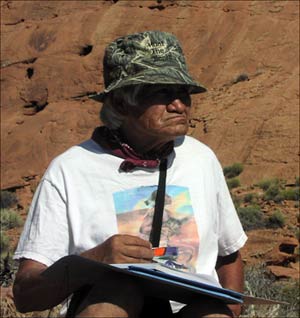Helping Hopi youth follow in the cultural footsteps of their ancestors just got easier for anthropologists at Northern Arizona University.
The National Endowment for the Humanities granted the Anthropology Department $240,990 to expand its recently completed project, Hopi Footprints: Building Better Teachers with a Community-based Culture Curriculum. The project will be extended for another three years.
“The Hopi are facing a challenging task of retaining their distinct cultural identity while preparing youth for successful participation in a fast-paced world of modern lifestyles and different cultures,” said George Gumerman, anthropology chair.
Uncovering the long history of the Hopi culture through archaeology and elder knowledge provides the foundation for Hopi Footprints, which launched in 2003. The project established a team of Hopi elders, cultural specialists, anthropologists, archaeologists and teachers to collaborate on preserving tribal traditions for future generations. They gathered and incorporated cultural material into lesson plans and teacher training at Hopi schools, and now are ready to broaden their reach.
“It’s time now to broaden this perspective by providing Hopi youth opportunities to connect with elders and scholars,” Gumerman said. “By uniting Hopi youth with their past, we believe they will help preserve their tribe’s traditions, and since they will be more connected to culturally relevant curriculum, they will be more likely to succeed in school and life in general.”
The newly funded project, Footprints of the Ancestors: Intergenerational Learning of Hopi History and Culture, connects youth with elders and scholars at historical and cultural sites across the Southwest, such as the San Juan River. Trips are also planned to Mesa Verde National Park, Navajo National Monument, Wupatki National Monument, the Museum of Northern Arizona, the National Museum of the American Indian and the National Museum of Natural History.
“We are bringing elders and youth together to rediscover Hopi roots and to revitalize the role of ancient places in Hopi life today while conveying their perspectives to the public,” he said. “We will work with the youth so after they visit powerful places they will communicate the knowledge they’ve gained by creating digital Hopi youth guides—DVDs, web sites, and podcasts—to the various venues.
“The Hopi Youth Guide to Navajo National Monument, for example, will consist of a DVD that presents the youths’ perspectives on the culture and history of Navajo National Monument and will include digital video interviews, maps, 3D images, photographs and artwork.”
He said the Hopi youth will also generate downloadable sound files of Hopi songs and stories that can be used as podcasts to inform and educate the public about the deep meaning of ancestral places.
“Imagine tourists listening to Hopi songs and stories on their iPod as they hike down the trail on their way to visit a site,” Gumerman said. “In addition to digital guides, the final product for the museum venues will be a cultural mini-exhibit produced in cooperation with the Museum of Northern Arizona.”
The initial Hopi Footprints project was funded by the Arizona Board of Regents and produced more than 25 hours of interviews with elders and archaeologists that have already been incorporated into accessible video, images, maps, CD-ROMs and web pages, which Hopi teachers and students use in their lessons and assignments.
According to Gumerman, this new stage of Hopi Footprints places the youth behind the camera and the computer. “Rather than the anthropologists doing the interviews and DVD production, the Hopi youth will interview tribal elders for cultural information that they will use to produce their digital Hopi Youth Guides,” he said.
The Hopi live in the oldest continuously occupied villages in North America and are located atop three high mesas in northeastern Arizona.
For information, go to www.idig.nau.edu.



